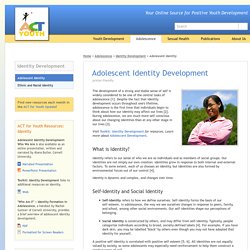

Implementing Critical Literacy with Adolescent Girls. The Huge Misconception About Reading. Empowering Adolescents Through Critical Literacy. Learning Language and Critical Literacy. Powerful Voices and Pens Articles. ACT for Youth - Adolescent Development Toolkit - Identity Development. Identity development is a central task of adolescent development.

Who am I? How do I fit in? What is my role? These are all key questions adolescents are asking themselves. Important dimensions of identity formation include race, ethnicity, gender, and sexual orientation. Adolescent Identity Development Narrated Presentation: In this presentation, you will learn to: define identity, identify the stages in adolescent identity development, distinguish between self-identity and social identity, and recognize the importance of identity development for youth. Narrated Presentation (13 minutes) PowerPoint Presentation "Who Am I? " Written by Rachel Sumner of Cornell University, this handout provides a brief overview of adolescent identity development. Handout Formatted for Screen Readers Identity Formation in Adolescence This article reviews identity formation during adolescence, presenting both theory and research.
Fact Sheet. Six Ways to Build Your Teen's Identity. In many ways, American teens have never had it tougher.

Perhaps a surprising statement, given the United States' obvious affluence compared to the rest of the world. If you're a parent today, you know what I mean. Social pressures are more pervasive and destructive than ever before in American history. Parents often feel helpless to equip their teens with the tools to navigate – and steer clear – of harmful relationships, attitudes and behaviors.
Ideally, the process of equipping our kids to live and thrive in an often Christian-hostile world begins as soon as they are born. Assisting your teen in forging a strong, positive identity is one way to help her form convictions based on truth, and then stand firm in them regardless of what everyone else does. As parents, we can build our teen's identity by using a brick mason's approach. Parental brick-layers labor alongside our teens as they experience the joy of discovering their significance in Christ and their identity.
The challenge? ACT for Youth - Adolescence - Adolescent Identity Development. The development of a strong and stable sense of self is widely considered to be one of the central tasks of adolescence [1].

Despite the fact that identity development occurs throughout one's lifetime, adolescence is the first time that individuals begin to think about how our identity may affect our lives [2]. During adolescence, we are much more self-conscious about our changing identities than at any other stage in our lives [3]. What ‘Mean Girls’ Taught Us. Ten years ago, no one had any idea what an iPhone was.

Bryan Cranston was still playing a sitcom father on Malcolm in the Middle, and the publishing industry was untouched by deadly teenage dystopias. Few people then could have predicted that a run-of-the mill teen film, focused on three “mean girls,” would explode with cultural impact the way it did. Yet, 10 years later, it stands out as one of the most culturally resonant high school movies of all time.
While “fetch” might not have happened, the cult following of Mean Girls definitely did. What is it that makes this film resonate with people enough to have them still quoting lines, a decade later? Everyone Is Terrified of Hearing, “You Can’t Sit With Us.” There were very specific rules to being able to sit with the “Plastics” at lunch. Even long after high school, wanting a place at the table can be a hugely motivating factor in what we choose to wear, do, say or act.
The “Uncool” Kids are Actually The Coolest. Fitting in is hard. Why Young Adults are Leaving the Church. What does it say about our generation that 40 to 50 percent of young Christians fail to stick with their faith or connect with a church after high school?

Most likely, you’ve experienced or been witness to this exodus of twentysomethings from the faith community. At this point, it’s not even surprising to watch young adults become disillusioned with church as they go to college, build a career, start a family or begin their “real life”. But can it be stopped? We recently spoke to Kara Powell, executive director of Fuller Youth Institute and co-author of Sticky Faith, to answer just that.
Drawing from her extensive research with Fuller Youth Institute, she gave us a little more insight into what it takes to find a faith that sticks. Do you think young people are just leaving the church, or leaving faith? Probably my best answer to that is to describe what Tim Clydesdale—who is a sociologist in New Jersey—refers to as “the identity lock-box.” The Influence of Peer Groups in Identity Development Article. Reviving Ophelia: Saving the Selves of Adolescent Girls: Mary Pipher, Ruth Ross: 9781594481888: Amazon.com: Books. Chimamanda Ngozi Adichie: The danger of a single story. Sarah-Jayne Blakemore: The mysterious workings of the adolescent brain.
Adolescent and Family Development Article. Gender Identity Issues in Children and Adolescents Article.